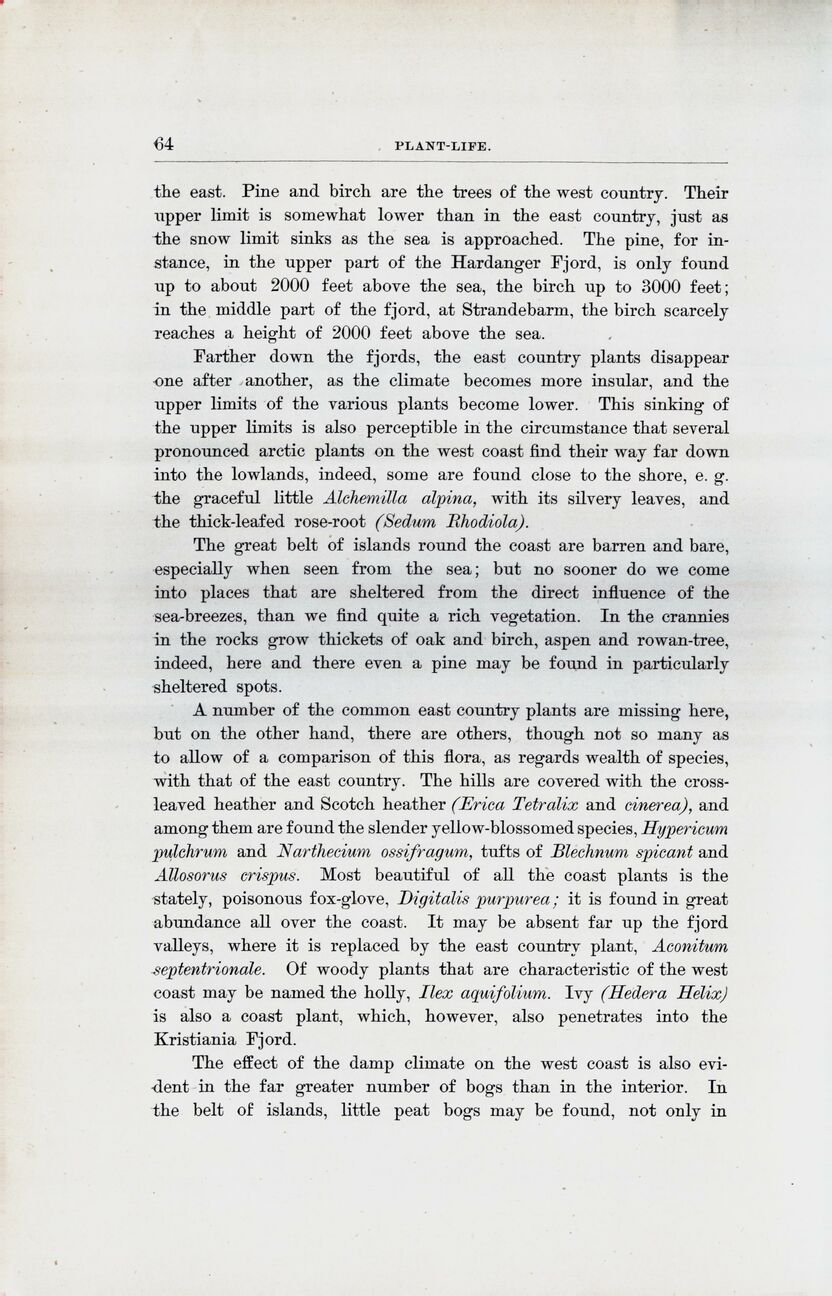
Full resolution (JPEG) - On this page / på denna sida - Plant Life, by H. H. Gran

<< prev. page << föreg. sida << >> nästa sida >> next page >>
Below is the raw OCR text
from the above scanned image.
Do you see an error? Proofread the page now!
Här nedan syns maskintolkade texten från faksimilbilden ovan.
Ser du något fel? Korrekturläs sidan nu!
This page has been proofread at least once.
(diff)
(history)
Denna sida har korrekturlästs minst en gång.
(skillnad)
(historik)
the east. Pine and birch are the trees of the west country. Their
upper limit is somewhat lower than in the east country, just as
the snow limit sinks as the sea is approached. The pine, for
instance, in the upper part of the Hardanger Fjord, is only found
up to about 2000 feet above the sea, the birch up to 3000 feet;
in the middle part of the fjord, at Strandebarm, the birch scarcely
reaches a height of 2000 feet above the sea.
Farther down the fjords, the east country plants disappear
one after another, as the climate becomes more insular, and the
upper limits of the various plants become lower. This sinking of
the upper limits is also perceptible in the circumstance that several
pronounced arctic plants on the west coast find their way far down
into the lowlands, indeed, some are found close to the shore, e. g.
the graceful little Alchemilla alpina, with its silvery leaves, and
the thick-leafed rose-root (Sedum Rhodiola).
The great belt of islands round the coast are barren and bare,
especially when seen from the sea; but no sooner do we come
into places that are sheltered from the direct influence of the
sea-breezes, than we find quite a rich vegetation. In the crannies
in the rocks grow thickets of oak and birch, aspen and rowan-tree,
indeed, here and there even a pine may be found in particularly
sheltered spots.
A number of the common east country plants are missing here,
but on the other hand, there are others, though not so many as
to allow of a comparison of this flora, as regards wealth of species,
with that of the east country. The hills are covered with the
cross-leaved [[** sjk bindestrek]] heather and Scotch heather (Erica Tetralix and cinerea), and
among them are found the slender yellow-blossomed species, Hypericum
pulchrum and Narthecium ossifragum. tufts of Blechnum spicant and
Allosorus crispus. Most beautiful of all the coast plants is the
stately, poisonous fox-glove, Digitalis purpurea; it is found in great
abundance all over the coast. It may be absent far up the fjord
valleys, where it is replaced by the east country plant, Aconitum
septentrionale. Of woody plants that are characteristic of the west
coast may be named the holly, Ilex aquifolium. Ivy (Hedera Helix)
is also a coast plant, which, however, also penetrates into the
Kristiania Fjord.
The effect of the damp climate on the west coast is also
evident in the far greater number of bogs than in the interior. In
the belt of islands, little peat bogs may be found, not only in
<< prev. page << föreg. sida << >> nästa sida >> next page >>